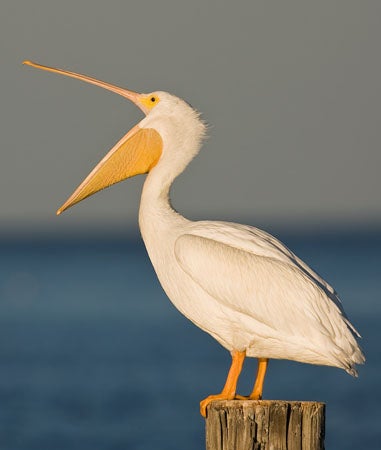SCIENTIFIC NAME:
Pelecanus erythrorhynchos
OTHER NAMES:
Pelican (blanc) Amerique (French)
Pelicano Norteamericano (Spanish)
STATUS:
Fairly common on Gulf Coast in winter, but uncommon in spring and summer. Recently has become locally common in Tennessee Valley region late fall thru early spring. Uncommon to rare in Inland Coastal Plain and Mountain regions in winter and during migration. Lowest Conservation Concern.
DESCRIPTION:
The American white pelican is a large white bird with black primary and secondary wing feathers. It can weigh as much as 30 pounds with a wingspan of eight to nine feet. In flight, it alternately soars and flaps with flocks flying in a V-formation with the neck bent and its head close to its body. It has a large yellow or orange bill with an extensible pouch, short legs, and webbed feet. Both sexes look alike and during the breeding season they develop a short yellowish crest on the back of their head and a horny ridge plate on the upper mandible.
HABITAT:
American white pelicans nest in two separate populations. West of the Rocky Mountains they nest in the upper Northwest from northern California, western Nevada, northern Utah, Idaho, and British Columbia. These birds winter along the Pacific coast, south to Guatemala. Pelicans nesting in the upper Midwest states and the Canadian prairie provinces winter along the Gulf Coast from Texas to Florida. They can be found on large rivers, lakes, estuaries, and bays.
FEEDING HABITS:
Unlike brown pelicans, American white pelicans do not plunge-dive to feed. They feed while swimming and work together in groups to encircle their prey, submerging their heads to catch fish and crustaceans. Generally, they consume about three pounds of food per day, but during the spring and summer, a breeding adult may eat the equivalent of 40 percent of its own body mass in a single day to provide food to its young. White pelicans can feed during the day or night and will fly 100 miles to a food source.
With the recent development of the aquaculture industry in west central Alabama numerous ponds and lakes have been created for fish production. White pelicans on their way to the Gulf have found an easy meal in these fish filled lakes. Fish farmers have to be vigilant to protect this crop from these unwelcome guests, as white pelicans can eat fish ranging in size from minnows up to 3.5 pounds.
In addition to eating farm raised fish, white pelicans have the potential to cause production losses by the transmission of fish parasites. White pelicans are the intermediate host for a trematode parasite that passes into the water through feces, attaches to snails, and then infects fish. Annual economic losses of fish production related to trematode infestations in the Southeast are estimated to be several million dollars.
LIFE HISTORY AND ECOLOGY: White pelicans nest in colonies and form a rimmed scrape by pulling any loose material to the nest with their large bill. Average clutch size is two eggs and both adults share incubation duties for 29 days. Foxes and coyotes have been known to steal eggs and young from the nest. White pelicans usually are silent but grunt or croak at the nest site.
The young, when first hatched, are naked, blind, and helpless. They soon begin to develop white wool-like down. Young pelicans are very unattractive in appearance at this stage and remain in the nest for about three weeks. Both adults feed the young by regurgitating a fishy soup to the front of their pouch. As young pelicans increase in size, they are fed more solid food which consists wholly of fish.
When about half-grown, the young pelicans are strong enough to leave the nest and they wander around their nesting colonies in droves. Adults returning with food have to wade through this mass of young pelicans wanting to be fed, until they find their offspring. Young white pelicans begin to fly in seven to ten weeks. Immature pelicans retain some grayish coloration until the following year. White pelicans are sexually mature in three to four years.
REFERENCES:
Imhof, Thomas A. Alabama Birds, Second Edition. The University of Alabama Press. Tuscaloosa, Alabama. pp 60-61.
National Geographic. Field Guide to the Birds of North American, Third Edition. pp 50-51.
Peterson, Roger Tory. Peterson Field Guides, Western Birds. Second Edition. Houghton Mifflin Company. pp 13-15
The Catfish Journal. December 2005. pp 13
AUTHOR:
Dave Nelson, Wildlife BIologist, Division of Wildlife and Freshwater Fisheries






